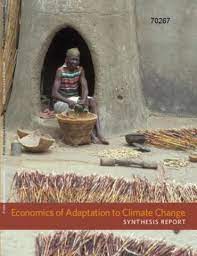🌿 COP 30 - Building a Greener Tomorrow
The 30th UN Climate Change Conference (COP 30) is taking place in Belém, Brazil. Stay informed about global climate actions, negotiations, and live sessions from 10 – 21 November 2025.
Get Updates
Economics of Adaptation to Climate Change SYNTHESIS REPORT

Files
Date
January, 2010Author(s)
- Sergio Margulis
- Urvashi Narain
- Kiran Pandey
- Laurent Cretegny
- Ana Bucher
- Robert Schneider
- Gordon Hughes
- Timothy Essam
Abstract
As developing countries weigh how best to revitalize their economies and craft a sustainable development path to boost living standards, they will have to factor in the reality that the global annual average temperature is expected to be 2º C above pre-industrial levels by 2050. A 2º warmer world will experience more intense rainfall and more frequent and more intense droughts, floods, heat waves, and other extreme weather events. As a result, it will have dramatic implications for how countries manage their economies, care for their people and design their development paths. Countries will need to adopt measures to adapt to climate change. These measures offer a way to make the effects of climate change less disruptive and spare the poor and the vulnerable from shouldering an unduly high burden. Against this backdrop, the global community adopted the Bali Action Plan at the 2007 United Nations Climate Change Conference. The plan calls for developed countries to allocate “adequate, predictable, and sustainable financial resources and new and additional resources, including official and concessional funding for developing country parties”1 to help them adapt to climate change. It also underscores that international cooperation is essential for building capacity to integrate adaptation measures into sectoral and national development plans.
Citation
Economics of Adaptation to Climate Change (EACC); Hard vs. soft approaches to adaptation;sustainable development;adaptation measures
Publisher
www.worldbank.org
Rights Holder
©2010 h e International Bank for Reconstruction and Development/h e World Bank 1818 H Street NW Washington DC 20433 www.worldbank.org socialdevelopment@worldbank.org
URI
https://knowledgehub.pksf.org.bd/collections/bEhMV3VBNVgrUExsT2JSbTU2Q2Jydz09
